Contents
Ising Model
The Ising model considers a lattice of paricles that have up or down spin. The total energy is given by the interaction of nearest neighbors and interaction of the spin with an external field.

Where the  means adjacent particles,
means adjacent particles,  is the field,
is the field,  is the spin, which can be either -1 or 1, and
is the spin, which can be either -1 or 1, and  is the interaction energy.
is the interaction energy.
https://en.wikipedia.org/wiki/Ising_model
The 1D Ising Model
clc close all clear all Beta=1; %1/KbT J=0; %Interaction Strength B=2; %Magnetic Field N=40; %Number of spins %Start with random orientation Spins=double(randn(N,1)>0); Spins(Spins==0)=-1; %Plot Spins X=(1:N)'; Y=Spins==-1; FigH=figure; FigH.Position=[200,300,900,400]; quiver(X,Y,X*0,Spins,0,'linewidth',2) axis([0 N+1 -1 2]) s=sprintf('Beta=%g, J=%g, B=%g',Beta,J,B); title(s) %Setup so we stop when figure is closed FigH.CloseRequestFcn='Go=0;'; Go=1; %Run Markov Chain Monte Carlo NChain=1000000; nn=0; while Go nn=nn+1; %counter for display %Make test jump %Pick site and flip spin ID=ceil(N*rand); SpinsTest=Spins; SpinsTest(ID)=-Spins(ID); %Energy from nearest neighbor interactions E_Spin=J*(Spins(1:end-1).*Spins(2:end)+Spins(1)*Spins(end)); E_SpinTest=J*(SpinsTest(1:end-1).*SpinsTest(2:end)+SpinsTest(1)*SpinsTest(end)); %Energy from Interactions with feild E_Field=-B*sum(Spins); E_FieldTest=-B*sum(SpinsTest); %Total Energy (Hamiltonian) H=E_Spin+E_Field; HTest=E_SpinTest+E_FieldTest; %Test acceptance probability for Metropolis-Hastings Alpha=exp(-Beta*(HTest-H)); %Metropolis-Hastings rule if rand()< (Alpha) Spins(ID)=-Spins(ID); end ShowIter=1; %Show every ShowIter interations if nn/ShowIter==round(nn/ShowIter) figure(FigH); hold off Y=Spins==-1; quiver(X,Y,X*0,Spins,0,'linewidth',2) axis([-1 N+1 -3 4]) title(s) hold on quiver(0,0,0,B,0,'linewidth',2) legend('Spins','Field') pause(.1) end end delete(FigH) figure; hold off Y=Spins==-1; quiver(X,Y,X*0,Spins,0,'linewidth',2) axis([-1 N+1 -3 4]) title(s) hold on quiver(0,0,0,B,0,'linewidth',2) legend('Spins','Field')

2D Ising Model
Same rules as the 1D Ising model. Neighbors are the 4 closest spins. In 2D there is phase transition at -1/(Beta*J)=2/log(1+sqrt(2))
clc close all clear all Beta=10; %1/KbT J=-.2; %Interaction Strength B=0; %Magnetic Field N=100; %Number of spins 2/log(1+sqrt(2)) -1/(Beta*J) %Start with random orientation Spins=double(randn(N,N)>0); Spins(Spins==0)=-1; %Plot Spins FigH=figure; %FigH.Position=[200,200,900,400]; imshow(Spins,[],'InitialMagnification',400) s=sprintf('Beta=%g, J=%g, B=%g',Beta,J,B); title(s) %Setup so we stop when figure is closed FigH.CloseRequestFcn='Go=0;delete(FigH)'; Go=1; %Run Markov Chain Monte Carlo NChain=1000000; nn=0; while Go nn=nn+1; %counter for display %Make test jump %Pick site and flip spin IDX=ceil(N*rand); IDY=ceil(N*rand); SpinsTest=Spins; SpinsTest(IDX,IDY)=-Spins(IDX,IDY); %Energy from nearest neighbor interactions E_Spin=J*(sum(sum(Spins(1:end-1,:).*Spins(2:end,:)))+... %Y neighbor sum(Spins(1,:).*Spins(end,:))+... %Y periodic BC sum(sum(Spins(:,1:end-1).*Spins(:,2:end)))+... %X neighbor sum(Spins(:,1).*Spins(:,end))); %X periodic BC E_SpinTest=J*(sum(sum(SpinsTest(1:end-1,:).*SpinsTest(2:end,:)))+... %Y neighbor sum(SpinsTest(1,:).*SpinsTest(end,:))+... %Y periodic BC sum(sum(SpinsTest(:,1:end-1).*SpinsTest(:,2:end)))+... %X neighbor sum(SpinsTest(:,1).*SpinsTest(:,end))); %X periodic BC %Energy from Interactions with feild E_Field=-B*sum(Spins(:)); E_FieldTest=-B*sum(SpinsTest(:)); %Total Energy (Hamiltonian) H=E_Spin+E_Field; HTest=E_SpinTest+E_FieldTest; %Test acceptance probability for Metropolis-Hastings Alpha=exp(-Beta*(HTest-H)); %Metropolis-Hastings rule if rand()< (Alpha) Spins(IDX,IDY)=-Spins(IDX,IDY); end ShowIter=1000; %Show every ShowIter interations if (nn/ShowIter==round(nn/ShowIter)) pause(.01);if ~Go;break;end % Time to process closed figure figure(FigH); try imshow(Spins,[],'InitialMagnification',400) catch end pause(.01) end end
ans =
2.2692
ans =
0.5000